
Switched Mode Power Supply (SMPS): Understanding Its Working, Types, and Benefits
Introduction to Switched Mode Power Supply (SMPS)
A Switched Mode Power Supply (SMPS) is an essential component in modern electronic systems, offering high efficiency and compact design. Unlike traditional linear power supplies, SMPS uses switching devices that turn on and off at high frequencies to convert electrical power. This allows for smaller, lighter, and more energy-efficient power conversion. Widely used in applications such as computers, battery chargers, and other sensitive electronics, SMPS ensures stable voltage output with minimal energy loss.
In this blog, we will explore the working principle, types, design, and advantages of SMPS over traditional power supplies. By the end of this article, you’ll gain a thorough understanding of SMPS and its numerous benefits for various applications.
What is Switched Mode Power Supply (SMPS)?
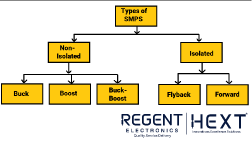
An SMPS is an electronic circuit that efficiently converts electrical power using high-frequency switching devices. It operates by turning switches (such as MOSFETs) on and off, utilizing inductors or capacitors to store energy when the switch is off. The primary function of SMPS is to adjust input voltage to the required output level while maintaining high efficiency.
Key Features of SMPS:
- High Efficiency: SMPS can achieve up to 90% efficiency, making it ideal for power-sensitive devices.
- Compact Size: With no need for large transformers, SMPS is much smaller and lighter than linear power supplies.
- Versatility: SMPS can either step-up or step-down the voltage to suit various electronic devices, such as LEDs, computers, 3D printers, and more.
Function of Switched Mode Power Supply (SMPS)
The main function of SMPS is to convert an input voltage into a stable output voltage required by electronic devices. The input can be AC or DC, and the output is always DC. SMPS achieves this using pulse width modulation (PWM) to regulate the output voltage.
By using a switching regulator, the system efficiently manages the power conversion, producing high power efficiency and a small form factor. SMPS uses several topologies, such as buck, boost, flyback, and forward converters, depending on the required output.
Why is SMPS More Efficient Than Linear Power Supply?
- Efficiency: SMPS is far more efficient, converting up to 60-65% of the input energy compared to 20-25% efficiency in linear power supplies.
- Power Dissipation: In linear power supplies, excess energy is dissipated as heat, which makes them bulky and less efficient, whereas SMPS uses minimal energy loss through switching.
Design & Working of SMPS

SMPS is composed of four primary sections: input stage, switching section, output stage, and control unit.
- Input Stage:
- The input voltage (AC or DC) is first rectified and filtered. The unregulated DC is then sent to the switching section.
- Switching Section:
- The heart of SMPS, this section uses high-speed switches (like MOSFETs) to convert the power. These switches operate at high frequencies, reducing size and increasing efficiency.
- A transformer is used to step down the voltage, ensuring efficient power conversion.
- Output Stage:
- The output from the switching section is passed through a rectifier and filter to convert it into stable DC voltage. This voltage is then sent to the control unit for feedback and regulation.
- Control Unit:
- The control unit monitors the output voltage and adjusts the switching frequency accordingly. It uses components like oscillators, amplifiers, and feedback sensors to ensure precise voltage regulation.

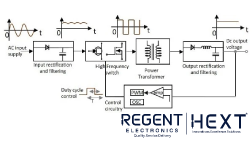
Types of Switched Mode Power Supply (SMPS)
SMPS comes in different types, each designed for specific applications. The most common types include:
1. Non-Isolated SMPS:
These converters do not provide isolation between the input and output. They are efficient for low-voltage changes but generate more noise.
- Buck Converter: A step-down regulator that reduces DC voltage.
- Boost Converter: A step-up regulator that increases DC voltage.
- Buck-Boost Converter: A hybrid converter that can both step up or step down the voltage.
2. Isolated SMPS:
These converters use a transformer for isolation between the input and output. They are ideal for applications requiring high isolation and safety.
- Flyback Converter: A simple and cost-effective isolated SMPS, commonly used for low-power applications.
- Forward Converter: Suitable for higher output currents, offering improved efficiency for more demanding applications.
SMPS Pinout
An SMPS typically has four pins, two for input and two for output, to facilitate easy integration with other systems.
| Pin Name | Description |
| IN+ | Positive input voltage |
| IN- | Ground (negative input) |
| OUT+ | Positive output voltage |
| OUT- | Ground (negative output) |
These pins are used for connecting to the power source and the device requiring the output voltage.
Why SMPS is Better Than Linear Power Supply?
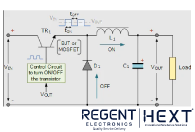
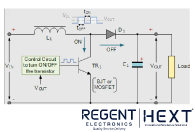
SMPS offers several advantages over Linear Power Supplies (LPS). Here’s a comparison of the two:
| Parameters | Linear Power Supply | Switched Mode Power Supply (SMPS) |
| Efficiency | Low (20-25%) | High (60-65%) |
| Weight | Bulky | Compact |
| Size | Larger | Smaller |
| Durability | Less Durable | More Durable |
| Cost | Higher | Cost-effective |
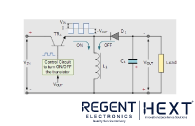
SMPS is more efficient, smaller, and durable than traditional linear power supplies, making it the ideal choice for most modern electronic devices.
Conclusion
A Switched Mode Power Supply (SMPS) is an essential component in powering modern electronic systems. With its high efficiency, compact size, and versatility, SMPS is used in a wide range of applications, from computers and mobile chargers to industrial equipment and LED lighting. Whether you’re designing a new device or upgrading an existing one, an SMPS will offer the power conversion you need with minimal energy loss.
At Regent Electronics, we offer a wide selection of high-quality SMPS solutions to suit various applications. Contact us today to find the right power supply for your project!
